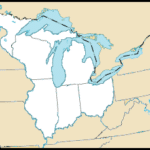
Who ever said that history was boring? In the Whiskey Rebellion, you have citizens on the verge of an insurrection, military suppression, and government debt. OK, government debt may not be that exciting, but understanding the Whiskey Rebellion will help you add nuance to your ideas about early America. Keep reading!
What was the Whiskey Rebellion?
Simply put, the Whiskey Rebellion was the armed resistance to excise taxes by the citizens of western Pennsylvania in 1794. It’s important for you to think of geography here: western Pennsylvania is mountainous. Like, really mountainous. Distilling the grain they harvested into whiskey made transportation of those goods to eastern markets much easier and profitable (a pint of whiskey was worth much more than a bushel of grain, as most early Americans loved their alcohol).
Everything was cool with this plan until Alexander Hamilton and other Federalists saw an opportunity to pay off the debt the fledgling country incurred from the Revolution War. As you can guess, wars are expensive. And the early Americans needed a way to pay back what they owed. So, Hamilton came up with a plan that included a slew of taxes and tariffs to increase the federal revenue. One such tax was the whiskey tax.
Are you seeing the problem here?
Western Pennsylvanians did, too. More taxes on whiskey means whiskey becomes more expensive, which means fewer people buy whiskey, which means…less money for western Pennsylvanians. After all, didn’t the country just fight a war because of taxes?!?
(Side note: western Pennsylvanians weren’t the only people who were upset by these proposed taxes. Most notably, Thomas Jefferson and other southerners were opposed to the idea of southern states – wealthier, respectively, than those in the North due to slavery – taking on other states’ debts. Hamilton appeased those southern politicians by agreeing to move the nation’s capital south, between Maryland and Virginia in what we now know as Washington, D.C. Others who disagreed with the taxes, too, but they simply did not pay them. The western Pennsylvanians mounted an armed resistance to the policy.)
Hamilton saw an opportunity, even here in this near uprising. Remember here that Hamilton was a Federalist; he believed in the power of a strong national government – and a rather loose constructionist view of the powers of the federal government granted by the Constitution. And he would use this rebellion to show the power of that strong national government through the military.
With Hamilton as the leader, 12,000 rag-tag soldiers came upon western Pennsylvania to squash the rebellion. However, when they arrived, most found that the resistors had stayed at home, rather than face such huge numbers.
Why is the Whiskey Rebellion so important?
There are several reasons why this rebellion was important. I will outline the most significant below, but I am sure you can think of more.
The Rebellion – and the interpretation of the Constitution that led 12,000 soldiers to stop it – laid out the powers of the federal government in practice. With its brand new Constitution, the federal government was able to flex its muscle (and make it clear that it was no longer operating under the weak Articles of Confederation) – even though there wasn’t much of a resistance to squash when the federal troops arrived.
What example about the Whiskey Rebellion may come up on the APUSH exam?
Examine the political cartoon below.

Political cartoon from 1794. Source here.
This political cartoon most directly reflects
(a) the belief that the tax collector is doing his job fairly.
(b) the perspective of farmers who are being taxed.
(c) the role of a strong, central government.
(d) how weak the federal government was.
The correct answer is (b). From this political cartoon, we can see that the two farmers – carrying their hoes and wearing simpler clothes than the tax collector – believe the tax collector to be a rascal. With knowledge of the Whiskey Rebellion, we understand that the tax collector was believed to be a “rascal” by the farmers, as he was carting off their distilled whiskey.
It is important to read the question closely. When AP asks for what the cartoon most directly reflects, it is your job to find the one BEST option. Other options may work, if you had more information, so they are not the most direct or best option for this question.






Leave a Reply